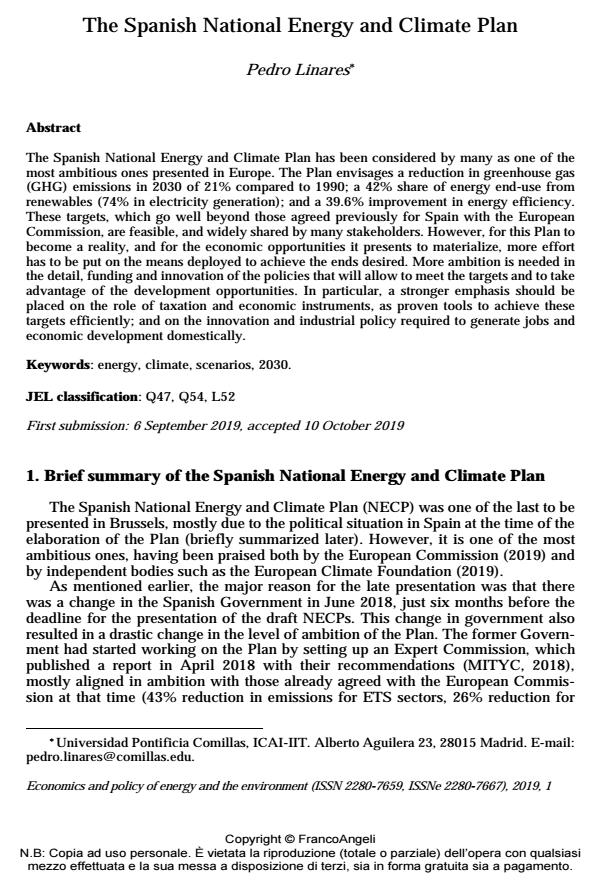The Spanish National Energy and Climate Plan
Journal title ECONOMICS AND POLICY OF ENERGY AND THE ENVIRONMENT
Author/s Pedro Linares
Publishing Year 2019 Issue 2019/1
Language English Pages 12 P. 161-172 File size 203 KB
DOI 10.3280/EFE2019-001010
DOI is like a bar code for intellectual property: to have more infomation
click here
Below, you can see the article first page
If you want to buy this article in PDF format, you can do it, following the instructions to buy download credits

FrancoAngeli is member of Publishers International Linking Association, Inc (PILA), a not-for-profit association which run the CrossRef service enabling links to and from online scholarly content.
The Spanish National Energy and Climate Plan has been considered by many as one of the most ambitious ones presented in Europe. The Plan envisages a reduction in greenhouse gas (GHG) emissions in 2030 of 21% compared to 1990; a 42% share of energy end-use from renewables (74% in electricity generation); and a 39.6% improvement in energy efficiency. These targets, which go well beyond those agreed previously for Spain with the European Commission, are feasible, and widely shared by many stakeholders. However, for this Plan to become a reality, and for the economic opportunities it presents to materialize, more effort has to be put on the means deployed to achieve the ends desired. More ambition is needed in the detail, funding and innovation of the policies that will allow to meet the targets and to take advantage of the development opportunities. In particular, a stronger emphasis should be placed on the role of taxation and economic instruments, as proven tools to achieve these targets efficiently; and on the innovation and industrial policy required to generate jobs and economic development domestically.
Keywords: Energy, climate, scenarios, 2030.
Jel codes: Q47, Q54, L52
- Economics for Energy (2017). Escenarios para el sector energético en España 2030-2050 -- https://eforenergy.org/docpublicaciones/informes/informe_2017.pdf.
- European Commission (2019). Communication from the Commission to the European Parliament,
- the Council, the European Economic and Social Committee and the Committee of the Regions. United in delivering the Energy Union and Climate Action – Setting the foundations for a successful clean energy transition. COM/2019/285 final.
- European Climate Foundation (2019). Planning for net zero. Assessing the draft National Energy and Climate Plans. May 2019 -- https://europeanclimate.org/wp-content/uploads/2019/05/Planning-for-Net-Zero.-Assessing-the-draft-NECPs.pdf.
- MINHAP (2014). Comisión de expertos para la reforma del Sistema tributario español. Informe -- http://www.hacienda.gob.es/es-ES/Prensa/En%20Portada/2014/Documents/Informe%20expertos.pdf.
- MITECO (2019). Estrategia de Transición Justa. Borrador -- https://www.miteco.gob.es/es/cambio-climatico/participacion-publica/5borradorestrategiatransicionjusta_tcm30-487304.pdf.
- MITYC (2018). Comisión de Expertos de Transición Energética. Análisis y Propuestas para la Descarbonización -- http://www6.mityc.es/aplicaciones/transicionenergetica/informe_cexpertos_20180402_veditado.pdf.
- Determinants and barriers of PV self-consumption in Spain from the perception of the installers for the promotion of distributed energy systems José Ángel Gimeno, Eva Llera Sastresa, Sabina Scarpellini, in ECONOMICS AND POLICY OF ENERGY AND THE ENVIRONMENT 1/2020 pp.153
DOI: 10.3280/EFE2020-001007 - Review of Energy and Climate Plans of Baltic States: The Contribution of Renewables for Energy Production in Households Dalia Streimikiene, Grigorios L. Kyriakopoulos, Gintare Stankuniene, in Energies /2022 pp.7728
DOI: 10.3390/en15207728 - 2024 IEEE 65th International Scientific Conference on Power and Electrical Engineering of Riga Technical University (RTUCON) Anatolijs Mahnitko, Inga Zicmane, Tatjana Lomane, Timurs Kuzņecovs, pp.1 (DOI:10.1109/RTUCON62997.2024.10830820)
- European roadmaps to achieving 2030 renewable energy targets Giacomo Di Foggia, Massimo Beccarello, in Utilities Policy 101729/2024 pp.101729
DOI: 10.1016/j.jup.2024.101729 - 2023 IEEE 64th International Scientific Conference on Power and Electrical Engineering of Riga Technical University (RTUCON) Anatolijs Mahnitko, Tatjana Lomane, Inga Zicmane, Timurs Kuzņecovs, pp.1 (DOI:10.1109/RTUCON60080.2023.10413049)
- The Spanish National Energy and Climate Plan Update 2023-2030: Welcome ambition, or magical thinking? Pedro Linares, in ECONOMICS AND POLICY OF ENERGY AND THE ENVIRONMENT 1/2024 pp.89
DOI: 10.3280/EFE2024-001006 - European Roadmaps to Achieving 2030 Renewable Energy Targets Giacomo Di Foggia, Massimo Beccarello, in SSRN Electronic Journal /2024
DOI: 10.2139/ssrn.4770915 - Methodology for Dimensioning the Socio-Economic Impact of Power-to-Gas Technologies in a Circular Economy Scenario Eva Llera-Sastresa, Luis M. Romeo, Sabina Scarpellini, Pilar Portillo-Tarragona, in Applied Sciences /2020 pp.7907
DOI: 10.3390/app10217907
Pedro Linares, The Spanish National Energy and Climate Plan in "ECONOMICS AND POLICY OF ENERGY AND THE ENVIRONMENT" 1/2019, pp 161-172, DOI: 10.3280/EFE2019-001010